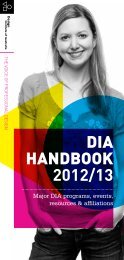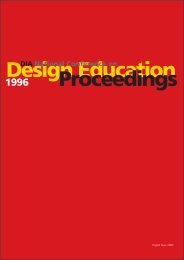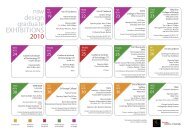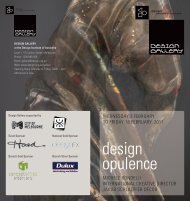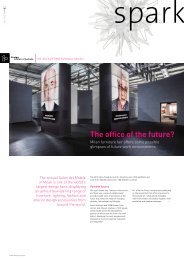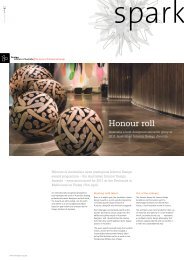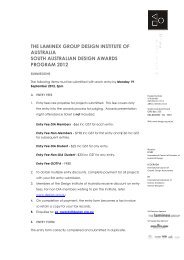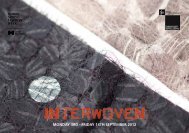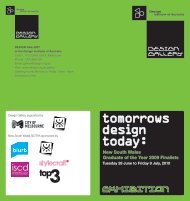Launch Report - Design Institute of Australia
Launch Report - Design Institute of Australia
Launch Report - Design Institute of Australia
You also want an ePaper? Increase the reach of your titles
YUMPU automatically turns print PDFs into web optimized ePapers that Google loves.
Steve Pozel, Director, Object, was asked: How do you engage the public in design?<br />
The transcript <strong>of</strong> Steve’s response is below.<br />
08<br />
Public Engagement<br />
When I was 15 in my home in Toronto, Canada I saw a<br />
documentary on the building <strong>of</strong> the Sydney Opera House. I<br />
was hugely impressed by a structure unlike anything I’d ever<br />
seen before, and concluded that <strong>Australia</strong> was a bold, exciting<br />
and forward-thinking country willing to take risks. I immediately<br />
announced to my parents that I was planning on moving<br />
to <strong>Australia</strong>.<br />
I’m relating this story because it illustrates the powerful and<br />
transformative impact <strong>of</strong> design. If we are to generate public<br />
engagement in design we have to stay cognisant <strong>of</strong> why design<br />
matters. Pr<strong>of</strong>essor Roy Green, Dean <strong>of</strong> the Business School<br />
at UTS, recently explained to me new data on aspects <strong>of</strong><br />
management performance that rated <strong>Australia</strong> relative to 15<br />
other countries. In the category <strong>of</strong> ‘instilling a creative mindset’<br />
we rated at the very bottom. These data show that <strong>Australia</strong><br />
lags in developing a creative culture, and this is a deficit <strong>Australia</strong><br />
simply cannot afford. I believe that public engagement in design<br />
is one important way <strong>of</strong> developing our creative culture. We can<br />
use design to empower our audiences with new tools to build<br />
capacity in critical and creative thought – an empowerment<br />
that can flow into all aspects <strong>of</strong> people’s lives.<br />
<strong>Australia</strong> already has excellent organisations and media to bring<br />
design to the public through online activity, and design festivals<br />
in several states, with exhibitions in major museums including<br />
the Powerhouse and Melbourne Museum, through public<br />
organisations like Artisan, Tasmanian <strong>Design</strong> Centre, Form and<br />
the Jam Factory. All this activity is valuable, but I believe we can<br />
do more to engage audience at a deeper level to foster creative<br />
and critical thought.<br />
The second project “Cusp” is currently in development. It will<br />
feature 15 designers and key works that we believe are likely to<br />
impact the decade ahead. The exhibition will not just look at<br />
outcomes, but will unravel the design process for the audience.<br />
It will communicate the processes involved in design, from<br />
original concept or problem and how it was resolved to improve<br />
our world.<br />
And finally “<strong>Design</strong> Emergency” an educational program that<br />
focuses on creative problem solving and goes directly into<br />
schools to work with both students and teachers. Imagine an<br />
ambulance, re-skinned so that it opens up with layers <strong>of</strong> tables<br />
and displays providing resources for a class to work through<br />
group challenges alongside two designers. It aims to stimulate<br />
children and their teachers to engage design thinking and<br />
creative problem solving and to use this “capacity building”<br />
knowledge both in and outside the classroom. Just as the<br />
National Arts Curriculum is about to commit to design and<br />
design thinking as key aspects <strong>of</strong> the arts curriculum, <strong>Design</strong><br />
Emergency looks to work with both students and teachers to<br />
build critical creative capacity in students.<br />
These initiatives are important because they help to build a<br />
society able to deconstruct problems and adapt to challenges<br />
with new solutions. The only thing we can be sure about<br />
the decades ahead is that the rate <strong>of</strong> change in society is<br />
accelerating exponentially. We need to build a society that<br />
thinks creatively and adaptively, as we will need a society that is<br />
able to react and adapt to massive change and challenge. This is<br />
where I believe the power <strong>of</strong> design lies today.<br />
I can only use Object as an example as it’s the organisation<br />
I’ve known for the last decade. We have been going through a<br />
transformative process ourselves as we explore how to engage<br />
differently with our audiences.<br />
[ 16 ]<br />
I would like to provide 3 examples. The Audio <strong>Design</strong> Museum<br />
is a new activity we have just launched in three cities including<br />
Sydney, Melbourne and Brisbane. The Audio <strong>Design</strong> Museum<br />
is a downloadable tour, which takes people into the streets<br />
and allows the public to follow architects, jewellers, fashion<br />
designers, and graphic designers in a discourse about what<br />
they are seeing on the streets and around them. We’re getting<br />
people to look closer at what they see on the streets every day<br />
when they walk down them: to view their environment with<br />
the eyes <strong>of</strong> a designer. We want to create collective stories and<br />
emotional experiences to really engage.




